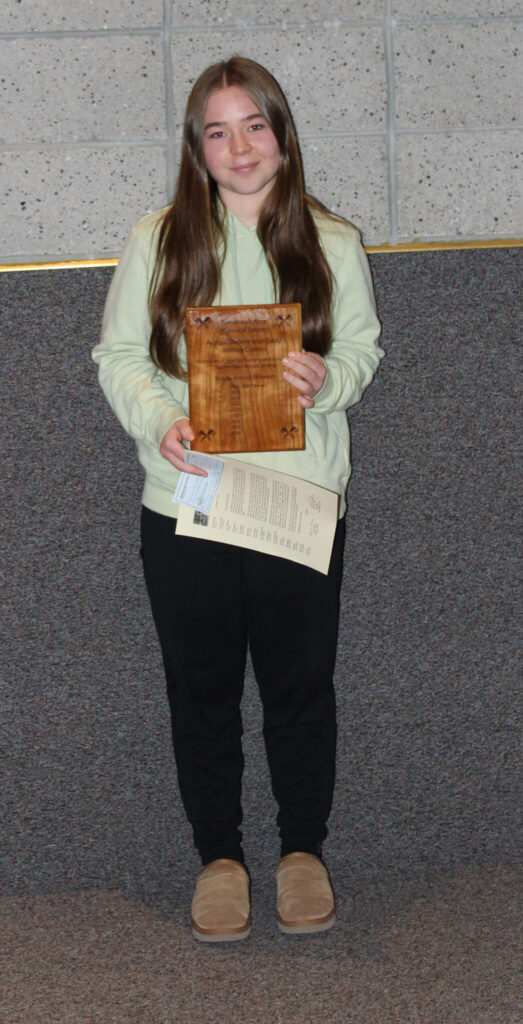By Cooper Kelley
Tomahawk High School History Teacher
TOMAHAWK – On Thursday, Dec. 21, the winners of the second annual Darlene Wurl History of Tomahawk Essay Writing Contest were announced in the Tomahawk High School (THS) auditorium.
Darlene Wurl was an educator at Tomahawk and dedicated her life to children and their writing and language skills. In conjunction with the Tomahawk Area Historical Society, Bill Sparr, Pat Pietilla, Caroline and Lloyd Bishop and the THS Social Studies Department, this has become an annual tradition to remember Darlene Wurl and the history of our community.
Over the course of the first semester of the school year, students took part in a process of writing about different historical events, people or themes in Tomahawk. During this time, students were able to visit the Historical Society on Oct. 26, 2023. From this, students were able to tour the facility and formulate ideas for their paper.
Students also had the opportunity to access the Tomahawk Public Library, books about Tomahawk and the Learning and Media Center at the high school.
After receiving submissions from nearly all of the class of 2026, a grading panel picked three winners that will receive a monetary prize from the Bishop family.
The following students are the winners of this year’s essay writing competition: First place, Jennie Frederickson, $100.00; second place, Freya Alberg, $75.00; third place, Edwin Riese, $50.00.
The student’s essay’s begin below.

William H. Bradley by Jennie Frederickson
Established in 1891, Tomahawk Wisconsin is a wonderful small town with a rich history. William H. Bradley was an essential figure in the history of Tomahawk. He was the founder as well as a businessman who made large contributions to the area. Bradley created a prosperous and lively city based on logging, the railroad system, and tourism. William H. Bradley made many accomplishments as the founder of Tomahawk. These accomplishments included organizing the Tomahawk Land and Boom Company, being head of the Bradley Brothers Lumber Company, creating the first Tomahawk Mill, building a dam in Tomahawk, and founding schools and churches. Tomahawk surely would not be what it is today without William H. Bradley.

William H. Bradley was born on February 25, 1838, in Bangor, Maine. Bangor was the typical logging town where Bradley gained his knowledge of forestry and lumber. Bradley took his knowledge of logging to the Midwest and began investing in Wisconsin timber. From 1862-1865 Bradley operated a sawmill in Oshkosh, Wisconsin. From 1865 to 1877 he operated a mill in Muskegon, Michigan (Wisconsin Historical Society). Shortly after, Bradley was drawn to Tomahawk due to the timber resources. He became head of the Bradley Brothers Lumber company, which was based in Tomahawk (Wisconsin Historical Society).
After moving to Tomahawk, Bradley began making many contributions to the area. The most notable contribution was the founding of Tomahawk in 1891. Bradley was very proud of his new city. The population instantly skyrocketed, a factor that led to this was the expansion of the railroad which brought more goods, supplies, people, and jobs. Bradley had many connections to the railroad and was a primary stockholder of it (Wisconsin Historical Society). The Tomahawk area was loved by many because of its lakes and rivers, timber, and agricultural opportunities.
William H. Bradley established many of the first corporations in Tomahawk including the Tomahawk Land and Boom Company, the mill, and the Bradley Bank (Go To Tomahawk). These companies boosted the economy of the young city, provided jobs, and established the high-scale production of lumber in Tomahawk during that time. Furthermore, Bradley assisted in establishing the first school which was later converted to the Tomahawk Historical Society. He also played a role in building churches, and the first general store (Hammond).
After a long life of advancing the Tomahawk community, William H. Bradley passed away in 1902 at the age of 64 (Go To Tomahawk). He will continually be remembered as a vital individual in the founding and upbringing of Tomahawk, Wisconsin. He founded companies and contributed to causes that shaped the future of Tomahawk, some of which are still around today. Bradley made a long-lasting impact on the community and Tomahawk would not be the same without him.
The History of Tomahawk Wisconsin by Freya Alberg
The city of Tomahawk, located in the Northwoods of Wisconsin, was officially founded in 1891. Nevertheless, the city started to take off much earlier than that in 1886. To the casual eye, Tomahawk may seem like a typical, boring city. However, when digging deeper into the history of Tomahawk, one can find various interesting aspects of the early days in the small city. Some of these aspects include bootlegging and moonshine operations, the Mitchell Hotel fire, and the Washington School fire.
Tomahawk was home to bootlegging and moonshine operations. Bootlegging is a term used to describe the smuggling of alcohol, while moonshine is a type of alcohol that was made illegally. These things were popular in the 1930s and 1940s, during the Great Depression. Making, selling, and smuggling liquor was a way that some people were able to get by during this time. There was also a gangster presence in the Northwoods including ties to the American crime boss, Al Capone (Oatman).
In 1929, a fire broke out known as the Mitchell Hotel fire. The fire damaged 18 buildings in downtown Tomahawk in a short period of 4 hours. The Tomahawk firemen’s efforts were proved to be inadequate due to a need for better fire-fighting tools. Firemen from surrounding communities including Merrill and Phillips even contributed to combat the flames. The fire ultimately went out at around 5:00 p.m. It left 10 families, occupying the apartments above, homeless as well as many more buildings in need of rebuilding. The fire was estimated to have caused $243,500 in damage (Mitchell Hotel).
The Washington school, located at Washington Square, caught fire on August 12, 1978. The cause of the fire was named accidental and believed to have started in the attic of the school. Firefighters from surrounding towns came to help, allowing control over the fire after 90 minutes of efforts. The fire resulted in no serious casualties. Nonetheless, damage to the school was significant, roughly calculated to be $1.5 million. The Washington School fire was a very significant part of Tomahawk’s history, being the town’s most expensive fire (Maki).
The history of Tomahawk, a small town in Northern Wisconsin, provides interesting aspects to the otherwise seemingly boring town. Bootlegging operations, the Mitchel Hotel fire, and the Washington School fire are just a few of the many factors that contribute to the intriguing history of Tomahawk, Wisconsin.
William Bradley and the Founding of Tomahawk by Edwin Riese
Back in the days of its founding, Tomahawk was a big logging town. William Bradley, its founder, was a logger and business owner who created the Tomahawk Land and Boom Company. Bradley came from a long line of loggers, so it was only right that Tomahawk was a town filled with sawmills and surrounded by trees. William Bradley was the start of Tomahawk and helped progress it since he was so involved.
On February 25, 1838, William Bradley was born in Bangor, Maine. Bangor was like a usual logging town, and Bradley wanted to continue the family business. During his youth, he wished to travel west to create a logging business, so he traveled to the Midwest to work. While traveling on the Wisconsin River, he announced that he would make a town on a stretch of water that he liked and would name it Tomahawk (American Lumberman). Since Bradley was living in Chicago, the easiest way to reach Tomahawk would be by train on the Chicago, Milwaukee, and St. Paul Railroad. The train to the Northwoods was extended to Minocqua in 1886, which allowed vast opportunities to progress Tomahawk (Tomahawk History).
In 1886, Bradley created his company, Tomahawk Land and Boom. Creating a treaty with the Chippewa Indians and buying land grants from a Canadian trapper allowed the town to flourish. Bradley created city Plans, land plots were sold, a dam was built, and in 1888, they constructed a sawmill next to the dam. In 1891, Tomahawk was incorporated as a town. More sawmills were created, along with buildings like Bradley Bank, stores, a shoe factory, a bank, and a park named Hog’s Back (now Bradley Park). Tomahawk produced large amounts of lumber during this time, with estimates showing numbers between 60-75 million feet being produced (Tomahawk History).
Bradley was a very involved founder, and always wanted to better the community of Tomahawk. He helped to fund and build schools for children, churches, hotels, and other buildings focused on the entertainment of the people. He created a general store and also helped establish a newspaper. Of course, Bradley also expanded Tomahawk’s lumber industry. For example, he built the Marinette, Tomahawk, and Western Road which connected to other towns to help the industry (American Lumberman). He enjoyed having a good time, and he and some of his friends organized a sort of pontoon boat train, where they traveled down the Wisconsin River to Somo. The boats were built with luxuries, and the people of Tomahawk enjoyed watching them come in. Bradley also helped create a toboggan run, a gazebo, and camps in Bradley Park.
Today, Tomahawk is a small, tight-knit community. What we have today all started with William Bradley and his wish to create a logging town. A young man from Maine created his town in the Northwoods of Wisconsin and helped it prosper. The people of Tomahawk should remember Mr. Bradley and what he did to create our small town.
